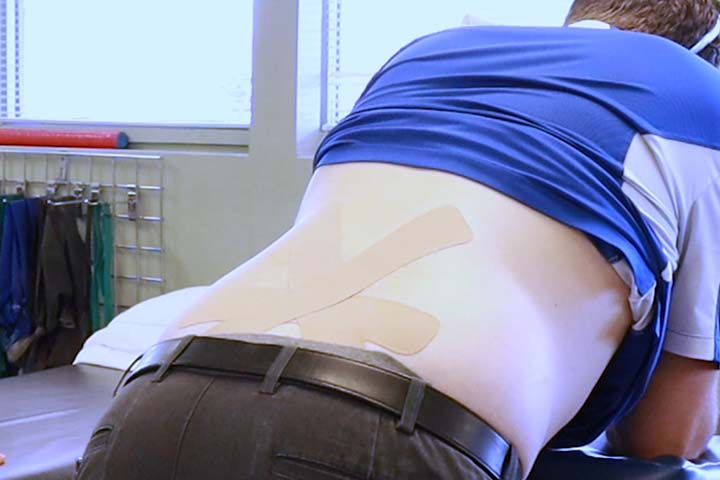We have addressed some of the most common causes of low back pain in previous articles. Today, I would like to go over one of the most helpful modalities we’ve found: using kinesio tape for lower back pain.
Kinesio tape is a good way to supplement your treatment for low back pain. It is a thin, elastic tape that is applied to the skin to provide support and reduce pain. The tape works by improving awareness of joint positioning, which improves function in the lower back. Kinesio tape can also increase circulation, decrease inflammation, improve posture, and improve muscle function, all of which can decrease stress on the lower back.
Patients are often tempted, when faced with back pain, to launch into self-diagnosis and mobility / flexibility work. However, as we can see, sometimes the opposite is what’s actually needed.
How Kinesio tape helps with lower back pain
Though we covered the topic in more depth in our article on how kinesio tape works, a short reminder on how kinesio tape works is in order:
It is surmised that Kinesio tape works by stimulating the skin’s receptors, thereby increasing the amount of “afferent” information (signals from body parts toward the brain) traveling through the peripheral nerves, into the spinal cord, and up to the brain.
This is to supplement the lack of information coming from tissue that has been overstretched. By increasing the amount of afferent information, it has been suggested that we allow the muscles to work more efficiently and helps irritated tissue to rest.
When to use kinesio tape on the low back
There is a segment of back patients that fall into the zone of “instability” that Kinesio tape can be very helpful in normalizing motion. This can lower the amount of time it takes these patients to feel relief for back pain.
Spinal instability may be classified on a continuum from simple hypermobility causing some pain, irritation, or the occasional back tweak. This can often be managed with exercise, bracing, ergonomics, and postural correction. It can also be classified as pathologically unstable which may require surgery, or anywhere in between these two extremes.
In cases of low back pain and instability that fall within the zone whereby added Afferent information may help normalize motion and rest irritated tissue, we will often use Kinesio tape to help “stabilize” the low back. The information provided through the skin by the tape is often immediately noticeable.
Note that the tape is NOT mechanically stabilizing the spine. A lumbosacral orthotic or back brace is needed for external stability of the low back. However, Kinesio tape may help with neurological stability offering an individual with low back pain, additional input about posture and joint position.
How to apply kinesio tape to the low back
We use several taping techniques and patterns with Kinesio tape when we work with patients experiencing low back pain. The specific pattern selected by our clinicians depends upon the nature of the low back pain.
In general, here is a basic pattern of applying kinesiology tape to the low back that works well. Note that you will likely need another person to help you apply KT tape:
- Find the position on the low back where the sacrum meets the lumbar spine on either side. This spot will be just at the top of the glute and a couple of inches off of the center of the spine on each side.
- Grab about 4 “boxes” worth of kinesio tape (about 8 inches worth), and lay it horizontally across the line between the two points identified above.
- With another 4-box (8-inch) tape strip, place the end on the top of the glute, and lay it at a 45-degree angle upwards across the back.
- Repeat on the other side.
The end result should be a “star pattern” on the low back, which will look something like this:

As stated earlier, there are several causes of low back pain and one size does not fit all. If you are experiencing low back pain, I encourage you to see a physical therapist in your area. Ask about the use of Kinesio tape in your particular case. We have had many patients that have responded well to the use of Kinesio tape in cases with low back pain.
Some notes about applying kinesio tape to the back
- As with all kinesio tape applications, we want to stretch the tape to about 50% of its maximum tension, to avoid irritating the skin.
- Make sure there are no bubbles or wrinkles in the tape, as this can also cause irritation and decrease its effectiveness.
- Leave the tape on for 3-4 days at a time, as long as it is helpful.
- You are welcome to shower with kinesio tape on, as long as you don’t scrub it with soap.
- If the tape itches or burns, you are welcome to remove it at any time.
We hope the above information has been helpful – we’ve had great success with using kinesio tape on our patients’ low backs, where appropriate. We have found that it is generally more helpful than the old athletic tape we used to use.
If you would like to discuss the usage of kinesio tape for your back pain or schedule a physical therapy consultation, feel free to reach out to us at any time!

















